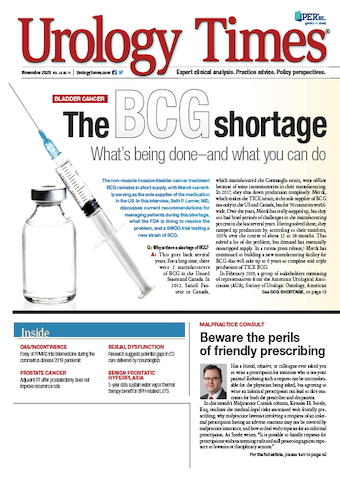Publication
Article
Urology Times Journal
CDC warns incidence of metastatic prostate cancer on the rise
Author(s):
Although the overall incidence of prostate cancer has declined, the percentage of patients with metastatic disease at diagnosis has increased over the last decade.
Over the past decade, the incidence of metastatic prostate cancer in the United States has been on the rise, according to an analysis published in the Centers for Disease Control and Prevention Morbidity and Mortality Weekly Report.1
Between 2003 and 2017, the percentage of patients diagnosed with metastatic prostate cancer increased from 4% to 8%. This increase occurred even though the overall age-adjusted incidence of prostate cancer in the United States went down from 155 per 100,000 in 2003, to 105 per 100,000 in 2017.
“Although approximately three-fourths of US men with prostate cancer have localized stage at diagnosis, an increasing number and percentage of men have received diagnoses of distant stage prostate cancer. Survival with distant stage prostate cancer has improved, but fewer than one-third of men survive 5 years after diagnosis,” the investigators wrote.
The CDC analysis examined data from the population-based cancer registries that are used for the official US Cancer Statistics (USCS) composite. Overall, there were 3,087,800 new prostate cancer cases diagnosed in the United States between 2003 and 2017. The incidence was highest among men aged 70-74 years and Black men. The vast majority of these cases were localized (77%), followed by regional (11%), metastatic (5%), and unknown (7%). Compared to all other races/ethnicities, White men had the lowest rates of metastatic (5%) and unknown stage (6%) disease at diagnosis.
Although the rate of patients diagnosed with metastatic disease increased between 2003 and 2017, in that same period, the rate of localized cases decreased from 78% to 70%, respectively. Survival data available for 3,104,380 men across all disease stages showed that between 2001 and 2016, the 5-year relative survival rate was 97.6% and the 10-year relative survival rate was 97.2%. The 10-year relative survival rates for men with localized versus metastatic disease were 100% versus 18.5%, respectively. The 10-year rates were 96.1% for patients with regional disease and 78.1% for patients whose disease status was unknown.
Of note, when comparing 5-year relative survival for the periods of 2001-2005 and 2011-2016, the rate improved from 28.7% to 32.3% in patients with metastatic disease. The authors suggested that the improvement might be attributed to recent advances in the prostate cancer armamentarium, including novel antibody and hormone treatments.
Although the 5-year survival rate was higher for White versus Black or Hispanic men when combining all stages of prostate cancer, the 5-year survival rate for patients with metastatic disease was higher for Black and Hispanic men compared to White men. The 5-year survival rates by race for men diagnosed with metastatic cancer between 2001 and 2016 were 42% for Asian/Pacific Islander; 37.2% for Hispanics; 32.2% for American Indian/Alaska Native; 31.6% for Black men; and 29.1% for White men.
The researchers wrote that one explanation for the recent uptick in the incidence of metastatic disease was the US Preventive Services Task Force (USPSTF) issuing a grade D recommendation in 2012 against the use of PSA screening in the general US population, regardless of age.
“This recommendation likely contributed to a decrease in overall reported prostate cancer incidence and might have contributed to an increase in the percentage and incidence of distant stage prostate cancer,” they wrote.
The current USPSTF PSA screening policy is slightly changed, with a grade C recommendation for men aged 55 to 69 years, meaning in this population, an individual decision on screening should be made based on a physician-clinician discussion of the potential benefits and risks. However, many urologists still find this recommendation lacking.
In their concluding remarks, the CDC investigators wrote, “Understanding incidence and long-term survival by stage, race/ethnicity, and age could inform messaging related to the possible benefits and harms of prostate cancer screening and could guide public health planning related to treatment and survivor care. Further research is needed to examine how social determinants of health affect prostate cancer diagnosis and treatment; findings should inform interventions to decrease disparities in outcomes.”
Reference
1. Siegel DA, O’Neil ME, Richards TB, Dowling NF, Weir HK. Prostate Cancer Incidence and Survival, by Stage and Race/Ethnicity — United States, 2001–2017. MMWR Morb Mortal Wkly Rep 2020;69:1473-1480. DOI: http://dx.doi.org/10.15585/mmwr.mm6941a1external icon


























